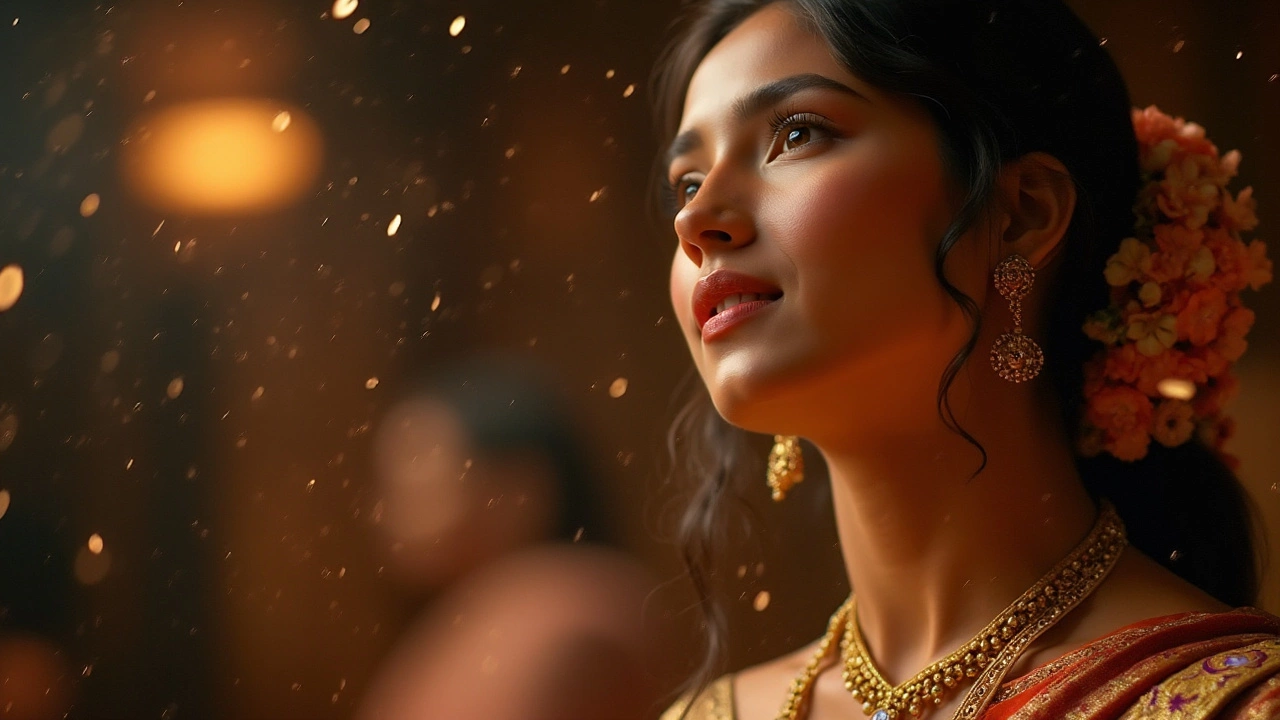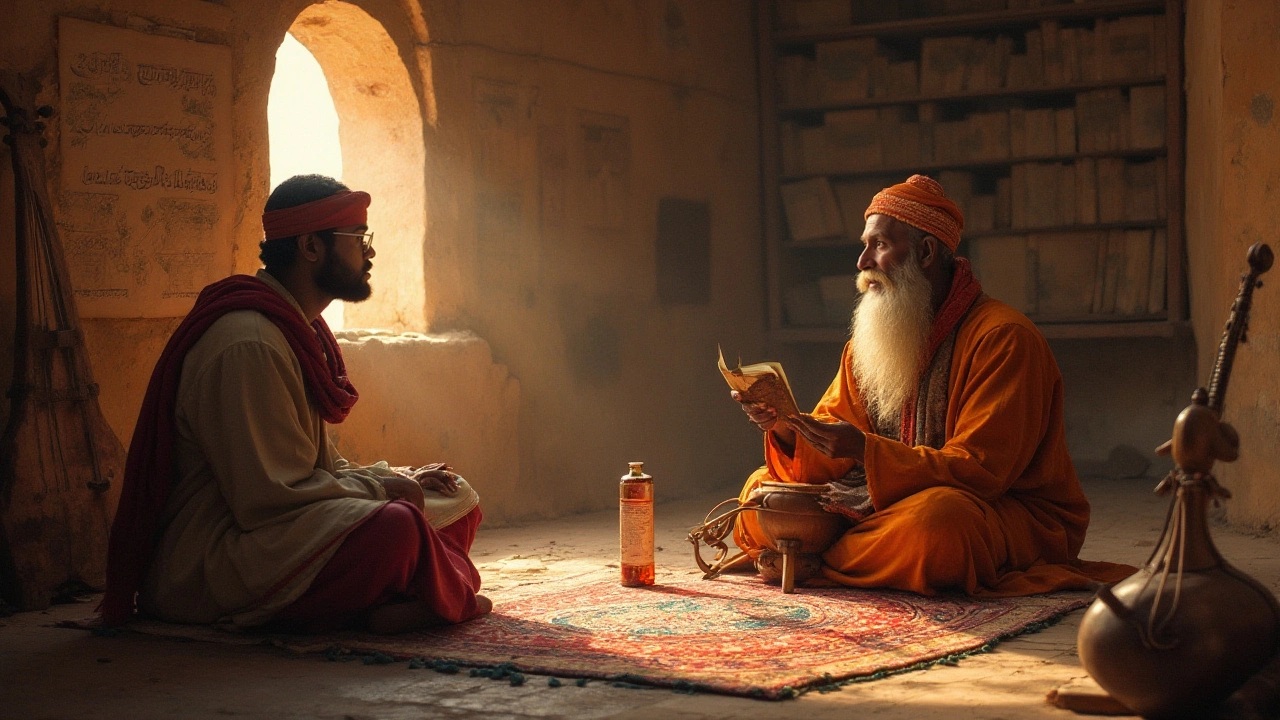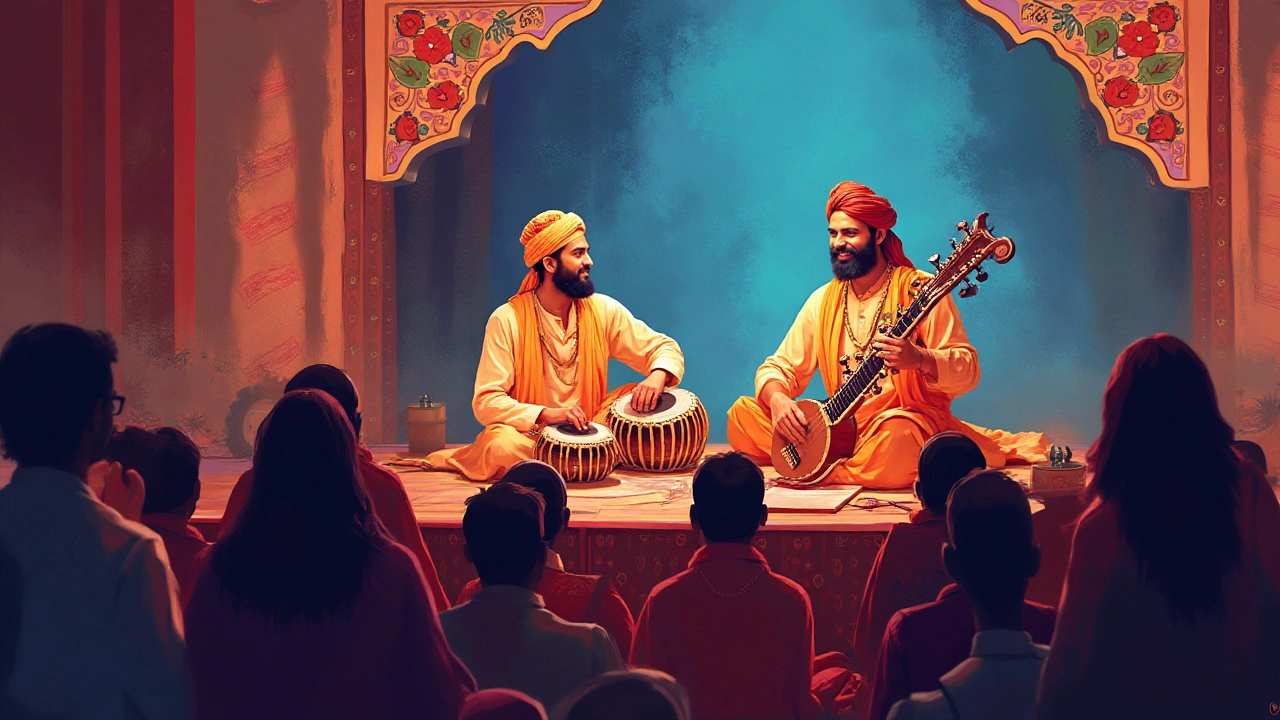Hindustani classical music is a remarkable tapestry woven from centuries of diverse cultural influences and rich tradition. Originating from the northern regions of the Indian subcontinent, it stands out not just for its complex blend of ragas and talas, but also for its captivating lyrics that draw from an array of languages. The lyrics, often steeped in spirituality and emotion, are usually composed in Hindi, Urdu, Braj Bhasa, or Awadhi, infusing the music with deep cultural resonance.
Unlike many other music forms, Hindustani music uses language as an essential tool for conveying intricate feelings and storytelling. Often, the choice of language in a composition is driven by the theme and intended emotional impact. As a result, understanding the language nuances is key to truly appreciating the depth of this art form. In this exploration, we delve into the historical roots of Hindustani music, dissect the primary languages employed within, and investigate how these languages enhance the music's emotional and cultural expressions.
- Historical Roots of Hindustani Music
- Predominant Languages Used
- Role of Language in Emotional Expression
- Cultural Significance and Diversity
- Preservation of Tradition Through Language
Historical Roots of Hindustani Music
Hindustani classical music has a profound history that stretches back to the ancient civilization of India. This rich musical tradition emerged from a confluence of cultural influences, both indigenous and from the Middle Eastern realms, during the course of India's long history. Its roots are deeply entrenched in the Vedas, the oldest sacred texts of Hinduism, which date back to around 1500 BCE. These texts contain references to music and chants as vital components of rituals, signaling the early beginnings of Indian music as a spiritual and ceremonial form.
The evolution of Hindustani music is further influenced by the arrival of Persian and Mughal influences around the 12th century. The fusion of the Indian and Persian styles led to the incorporation of new instruments like the sitar and tabla, which have now become emblematic of the genre. During the Mughal era, music saw significant patronage and flourished in the royal courts, which helped in refining its nuances and expanding its theoretical framework. This period also marked the introduction of ragas, the melonic frameworks that are essential to the Hindustani music repertoire, providing a foundation for improvisation and composition.
"Music is universal in its reach and is appreciated universally. What continues to attract is the mellowness and the diverseness of Indian classical music, both technically and melodically," noted renowned musician Pandit Ravi Shankar in one of his interviews.
As Hindustani music evolved, it adapted to various languages, each imparting their unique lyrical beauty to compositions. The Dhrupad, an ancient genre within the tradition, primarily utilized Sanskrit, while Khayal, a more recent form that gained prominence in the 18th century, often drew from Hindi or Urdu. This linguistic adaptability not only reflected the language of music during different times but also the socio-political shifts and cultural exchanges occurring within India.
In contemporary times, Hindustani music continues to thrive, retaining its historical essence while dynamically adapting to modern influences. From its ancient ritualistic roots to a celebrated art form performed globally, Hindustani music underscores the enduring bond between language, music, and cultural heritage. This historical journey elucidates how music not only survives but flourishes by embracing diversity and innovation, much like the society from which it originates.
Predominant Languages Used
In the exquisite realm of Hindustani music, language plays a pivotal role. This facet of Indian classical music showcases a rich tapestry of linguistic diversity. Predominantly, the languages that have etched their presence in this music genre include Hindi, Urdu, Braj Bhasa, and Awadhi. Each language, with its own historical and cultural essence, contributes uniquely to the art form, offering a different palette of sounds and meanings. The use of these languages extends beyond mere lyrics; they embody the soul of the compositions, transforming simple melodies into profound expressions of human emotion and spirituality. The melodic compositions set in these languages are performed across various platforms, from intimate gatherings to grand stages, each time connecting the audience to a deeper cultural ethos.
Hindi, one of the most widely spoken languages in India, finds its prominence in many classical compositions. Its straightforward phonetic structure makes it accessible, while its poetic versatility allows artists to explore a plethora of themes—from love to devotion, and nature to philosophy. As the primary language for many esteemed poets and lyricists, Hindi has carved a significant mark in Hindustani music's narrative traditions. Urdu, known for its eloquence and rich poetic heritage, also plays a central role in this auditory art. It is particularly revered in ghazals and light classical music forms. The softness and elegance embedded in Urdu's script are mirrored in the music it accompanies, creating an almost ethereal experience for the listeners.
Musicologist Ashok Ranade once highlighted, "The beauty of Urdu in Hindustani music is like silk thread knitting through pearls, each word adding to the luster of the composition."
Languages like Braj Bhasa and Awadhi hold deep roots in the spiritual and philosophical narratives of Hindustani music. Braj Bhasa, once the language of choice for many devotional and classical music forms during the medieval period, continues to echo in compositions dedicated to Krishna and Radha. This language offers a quaint charm, its diction resonating with the rhythms of pastoral life and divine love stories. Awadhi, with its lyrical grace, has been immortalized in folk and classical musical landscapes, often accompanying stories of heroics and spirituality. It brings to life the tales of revered figures and moral narratives, enriching the music with cultural heritage.
An interesting observation in these compositions is how languages adapt to evoke specific emotive landscapes. The choice of language can distinctly color the raga, influencing how listeners perceive and feel the music. For instance, a thumri in Braj Bhasa might portray tender love, while the same raga in Urdu might take on mystical overtones, inviting introspection. This interplay of language and music underscores the significance of linguistic diversity in Hindustani music’s immersive experience. In addition to these primary languages, regional dialects, and languages occasionally find their way into local compositions, reflecting the geographical and cultural variety inherent in India's vast landscape. These regional inflections add another layer of depth and identity to the music, making each performance a unique narrative told in a melange of sounds and symbols.

Role of Language in Emotional Expression
In Hindustani classical music, the intricate relationship between language and emotion is pivotal to its allure and depth. The selected language in a composition significantly influences not just the aesthetic experience of the listener, but also the emotional connection and expression conveyed by the artist. For instance, the rich and poetic quality of Urdu is often harnessed for its nuanced ability to express complex emotions such as longing and melancholy. The fluidity and elegance of Urdu couplets enrich musical performances, allowing artists to fully immerse their audience in a world of emotional depth. Similarly, Braj Bhasa and Awadhi capture the devotional and romantic fervor often associated with this era, using their lyrical simplicity to convey profound sentiments that resonate on a spiritual plane.
This emotional expression is deeply rooted in the traditional themes commonly explored in Hindustani music, from medieval romance to spiritual devotion. The diverse yet harmonious integration of these languages enables artists to explore a vast emotional spectrum, providing listeners a portal into various human experiences. It is as if the language itself becomes an instrument, playing its own melody within the larger canvas of the composition. The inherent characteristics of each language, such as its phonetics, cultural context, and historical background, play an essential role in shaping the music’s emotive power.
The use of language in Hindustani music is not merely about conveying explicit meanings; it is equally about evoking an emotional ambiance that transcends the literal. According to renowned musicologist Ashok Ranade, "the strength of Hindustani music lies in its capability to induce a range of emotions through its captivating melodies and well-chosen lyrics."
"The strength of Hindustani music lies in its capability to induce a range of emotions through its captivating melodies and well-chosen lyrics."The deliberate choice of words and the interplay of melody and language create a dynamic interplay, crafting an emotional journey that can transport listeners to introspective realms or communal celebrations.
In conclusion, understanding the language of Hindustani music unlocks a deeper appreciation for its expressive potential. By weaving together languages like Hindi, Urdu, and Awadhi with masterful musical compositions, this classical form not only preserves cultural narratives but also continues to touch hearts across generations. Aspiring musicians are encouraged to delve into the linguistic subtleties of Hindustani music to harness its full expressive power, thereby continuing its vibrant legacy. So, whether you're a dedicated listener or an aspiring performer, immersing oneself in the linguistic traditions of Hindustani music can offer a more profound connection to its emotive essence, enriching both the art form and the soul of those who engage with it.
Cultural Significance and Diversity
The vibrant canvas of Hindustani music, with its melodic artistry, carries a rich tapestry of cultures, languages, and traditions unique to the Indian subcontinent, reflecting a remarkable cultural fusion. With roots deeply established in regions like North India, Pakistan, and Nepal, this music tradition acts as a binding thread that weaves through the diverse ethnic and linguistic communities. The use of multiple languages, such as Hindi, Urdu, Braj Bhasa, and Awadhi, offers this genre a unique versatility that not only enriches its musical portfolio but also caters to an array of linguistic preferences, thereby enhancing its accessibility and cultural reach.
The diversity in language usage within Hindustani classical music is not merely a coincidental choice but a conscious artistic decision that amplifies the emotive power of the compositions. Each language contributes distinct nuances and subtleties that help articulate complex human emotions and spiritual themes. As a result, the lyrics can resonate deeply, painting vivid imagery and evoking heartfelt responses from the audience. Take the language of Urdu, for example; its intrinsic beauty and poetic nature often add a lyrical softness and romantic depth to classical romance-centered ragas.
Historical narratives suggest that the evolution of Hindustani music languages was influenced significantly by the Bhakti and Sufi movements, which spread across India, emphasizing emotional union with the divine. These movements encouraged a variety of expression forms, allowing myriad regional languages to flourish through music. Scholars often point out that music became a language of unity during these periods, fostering a cultural dialogue that transcended beyond mere communication, fostering widespread spiritual reawakening. This amalgamation of languages within music provided a platform for promoting communal harmony, navigating intricate societal hierarchies, and unifying people through shared expressions of joy, love, and divinity.
"Language is the dress of thought, and Hindustani music uses it to adorn feelings in the most elegant way," opines musicologist Anjali Ghosh, hinting at the profound relationship between lyrics and emotive expression in music.
Moreover, the strategic use of multiple languages in Hindustani music not only ensures its preservation but also promotes the continuation of cultural stories and values in various communities. This diverse linguistic use acts as a protective shield against cultural erosion, allowing native languages to thrive. In contemporary times, this diversity also enables Hindustani music to transcend geographical borders, introducing the beauty of Indian classical music to global audiences.
Interestingly, the role of language in this music genre is so pivotal that certain compositions gain popularity based solely on linguistic appeal. For performers and audiences alike, deciphering the linguistic intricate meanings and inflections becomes an enriching experience, ensuring the timeless relevance of Hindustani classical music. The craft of weaving together music with words, drawn from diverse cultural backgrounds, truly makes it an ambassador of India's rich cultural mosaic and an invaluable art form that continues to thrive in the modern era.

Preservation of Tradition Through Language
In the realm of Hindustani music, language serves as a vital vessel for carrying forward centuries-old traditions, ensuring that the cultural heritage inherent in this classical form is not lost but rather cherished and continued. The use of native languages such as Hindi, Urdu, Braj Bhasa, and Awadhi not only anchors the music to its regional roots but also makes it accessible and relatable to audiences who share these linguistic backgrounds. Each performance thus becomes a celebration of the past and a bridge to contemporary soul, linking musicians and listeners across generations.
Language in Hindustani classical music is more than just a medium of lyrics; it is an embodiment of the stories, philosophies, and emotions of the time it emerged from. These lyrics carry forward tales of mythological epics, devotional prayers, and royal court life, all preserved with the linguistic characteristics of their origin. For example, the verses in Braj Bhasa often recount episodes from the lives of deities like Krishna, a language choice that enriches the storytelling aspect through its poetic and rhythmic sound.
The role of language in preserving these traditions is powerfully exemplified by the works of celebrated poets and composers such as Amir Khusro and Tulsidas, whose compositions in Persian and Awadhi, respectively, are still performed centuries later. Maintaining these languages in music not only preserves the compositions themselves but also keeps the languages alive, nurturing their ongoing relevance. As pointed out by renowned musicologist Ashok Ranade, “Hindustani music's reliance on language is its gift and its guardian — it encases the cultural essence that the music imparts to every listener, a safeguard against the passing of time.”
Moreover, the preservation effort extends to formal training and pedagogy, where traditional compositions are taught in their original languages to students of classical music. This educational approach ensures that the linguistic and cultural nuances remain intact. Many music schools and institutions emphasize the importance of learning and performing these pieces in their authentic linguistic forms, which aids learners in internalizing the art form's cultural depth and historical significance. In addition, by encouraging students to compose new works in these classical languages, the continuity of tradition meets the innovation of new generations.
The dual role of language as a preserver and propagator has particular significance for those looking to understand the rich tapestry of Indian classical music. As global interest in Hindustani music grows, language becomes a tool not just for musicians but for scholars aiming to decode the socio-cultural, religious, and historical narratives embedded within. The efforts to translate and interpret these musical works into modern languages help introduce a wider audience to the music’s intricate beauty while honoring its deep-rooted context.
